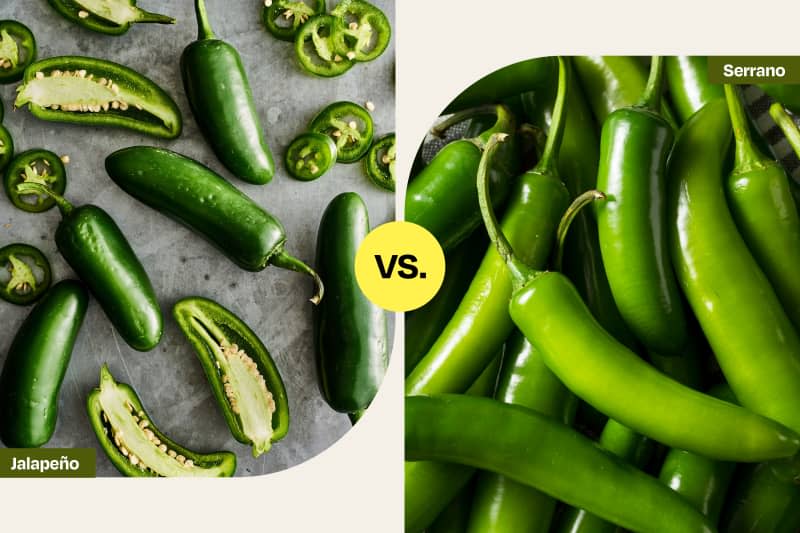Jalapeño vs. Serrano Peppers: What’s the Difference?

When you’re looking to add some heat to a dish, there are a lot of peppers you could reach for. Two of the most common varieties are also pretty easy to mix up: jalapeños and serranos. They’re both green and similar in size, and both can bring the heat. Plus, both jalapeño and serrano peppers can be eaten raw, pickled, or cooked. They are frequently used in many cuisines, including Mexican and Vietnamese, and can be added to anything from guacamole to corn muffins (they also make great salsa!). Here, we break down the differences between these popular peppers.
What Are Jalapeño Peppers?
This produce section staple is one of the most well-known spicy peppers. They’re pretty small, usually between 2 and 4 inches long. When compared to hot peppers in general, they’re pretty mild, with a reading on the Scoville scale of 2,500 to 10,000 (as opposed to the habanero, for example, which has an Scoville Heat Level of 150,000 to 350,000). Although they can still pack a punch.
Originating in Mexico, this pepper is often harvested before fully ripening, hence its green color. Ripe jalapeños (which are red) can be smoked, which transforms them into chipotles. Jalapeños have a fruity, grassy flavor and are used in everything from a classic chili to grilled cheese. Read more about how to prep, cook, and eat jalapeños here!
What Are Serrano Peppers?
Serrano peppers are generally smaller and skinnier than jalapeños. Despite their small size, they can be up to 10 times hotter than a jalapeño, so tread carefully. They’re often sold in their underripe green form in grocery stores, but you can also find them in yellow, orange, and red. Serranos originate in Mexico just like jalapeños and have a similar bright, fresh flavor.
Can You Swap Jalapeños and Serranos?
You sure can! These two peppers have similar, complementary flavors that make good stand-ins for each other. However, don’t forget that serranos are hotter than jalapeños, so depending on your spice tolerance, you may want to adjust the amount of pepper you’re using accordingly.
How to Store Peppers
Fresh peppers keep well in the refrigerator, stored inside a plastic bag, where they should keep for a week or two. Don’t worry about washing them until you’re ready to use them, as the addition of moisture can speed up spoilage.
If you want to store fresh peppers for longer, keep them in the freezer in an airtight container or zipper-lock freezer bag. Previously frozen peppers will work well in dishes where they will be cooked, but stick with fresh peppers if you’re planning to eat them raw.

